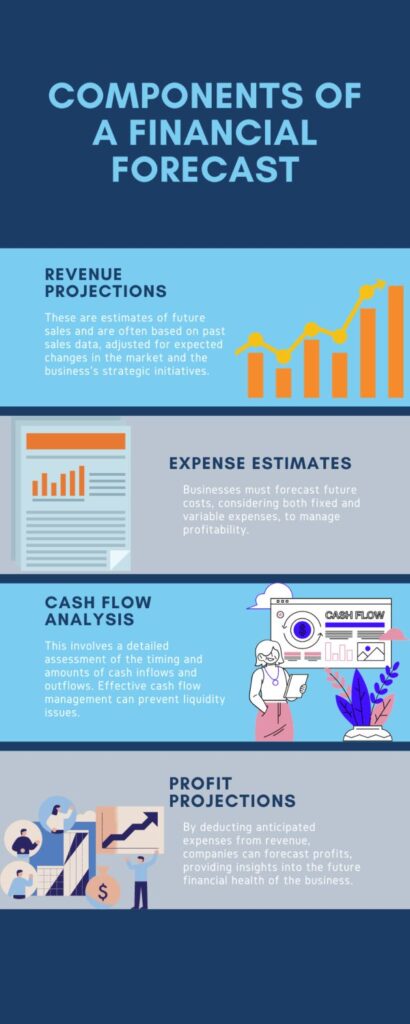
Financial Forecasting for Growth: A Strategic Guide for Entrepreneurs and Law Firms

Financial forecasting serves as the navigational chart for businesses, directing entrepreneurs and law firms through the turbulent seas of economic change. It is the strategic process of projecting future financial performance based on historical data, market analysis, and industry trends.
Proper financial forecasting equips firms with a powerful tool to anticipate financial requirements, gauge potential risks, and allocate resources effectively. For law firms in particular, this becomes instrumental in creating budgets, addressing cash flow needs, and focusing investments towards areas of prospective growth.
While the fundamental principles of sound financial forecasting are universal, their application can differ significantly across industries. In the context of law firms, where billable hours and case outcomes can be unpredictable, forecasting becomes essential to manage financial stability.
Key Takeaways
- Effective financial forecasting is crucial for strategic planning and resource allocation.
- Law firms benefit from tailored forecasting to navigate unique financial challenges.
- Advancements in forecasting tools enhance accuracy and inform better decision-making.
The Essentials of Financial Forecasting
Financial forecasting stands as a fundamental component in strategizing for business growth, allowing entrepreneurs and law firms to anticipate revenues, manage expenses, and optimize cash flow.
Understanding Financial Forecasting
Financial forecasting is the process of predicting a company’s financial outcomes by examining historical data and identifying trends. It allows businesses to estimate future revenue, profits, and cash flow, and it is critical for making informed, strategic decisions. This methodology relies on analyzing historical sales and expenses, and it incorporates external macroeconomic factors alongside organization-specific conditions to provide a comprehensive financial projection.
Components of a Financial Forecast
A financial forecast is typically comprised of several key elements:
- Revenue Projections: These are estimates of the future sales and are often based on past sales data, adjusted for expected changes in the market and the business’s strategic initiatives.
- Expense Estimates: Businesses must forecast future costs, considering both fixed and variable expenses, to manage profitability.
- Cash Flow Analysis: This involves a detailed assessment of the timing and amounts of cash inflows and outflows. Effective cash flow management can prevent liquidity issues.
- Profit Projections: By deducting anticipated expenses from revenue, companies can forecast profits, providing insights into the future financial health of the business.
Financial forecasts serve as blueprints for decision-making, budgeting, and guiding organizations toward their financial objectives.
As we dig into the dominion of strategic financial management, it’s important to consider innovative approaches that can significantly elevate your firm’s efficiency and effectiveness. One such approach is the outsourcing of accounting services, which can offer not just cost benefits but also access to specialized expertise and advanced technologies.
Discover why accounting outsourcing is a strategic game-changer for businesses in our in-depth analysis.
This exploration will provide you with insights into how outsourcing can transform your financial operations, allowing you to focus more on core business growth and less on administrative complexities

The Strategic Role of Forecasting in Growth
Effective financial forecasting serves as a fundamental tool, integrating growth aspirations with pragmatic strategic planning. It illuminates pathways for advancement while aligning stakeholders’ expectations.
Connecting Forecasting to Business Strategy
Financial forecasting provides a quantifiable basis for strategic planning, allowing businesses to map out scalable growth trajectories. It helps identify growth opportunities by leveraging past performance data to predict future outcomes.
For instance, an entrepreneur can use forecasting to anticipate market demands, align investment with product development, and tailor resources to seize competitive advantages. Law firms, alike, can apply forecasting to gauge case volume and optimize billing strategies, thus ensuring resource allocation supports strategic expansion goals.
Facilitating Better Decision-Making
By offering a forward-looking perspective, financial forecasting empowers entrepreneurs and law firms to make informed decisions. This is critical for evaluating potential business moves in terms of financial viability and risk. Stakeholders depend on forecasts to justify business decisions; they provide a clear viewpoint on expected profitability and financial health.
A law firm might use these forecasts to decide whether to enter a new legal market or hire additional staff, while an entrepreneur could leverage them to determine pricing strategies or product launch timings. Robust forecasting contributes to robust decision-making processes, integrating data analysis with business insights—unveiling strategic decisions that foster growth and stability.
In addition to mastering financial forecasting, another strategic move for enhancing your firm’s financial management is considering the role of external expertise. Outsourcing certain financial functions, like bookkeeping, can provide not only cost savings but also access to specialized skills and technology. Understand how outsourcing bookkeeping can strategically enhance your firm’s financial management, offering you more time to focus on core business activities while ensuring precise financial oversight.
This approach can be particularly beneficial for law firms looking to streamline operations and optimize financial performance.
Financial Forecasting Techniques
Financial forecasting is a critical strategic tool that helps entrepreneurs and law firms anticipate and prepare for future financial states. By understanding and applying specific forecasting methods, these businesses can better align their financial goals with market expectations and operational capabilities.
Quantitative Forecasting Methods
Quantitative forecasting methods employ statistical and mathematical models to predict future financial outcomes. One common quantitative method is simple linear regression, which predicts a variable based on the relationship with another variable. For instance, a firm might predict future sales based on past advertising spend. This method assumes a straight-line relationship between the two variables.
Multiple linear regression goes a step further by using multiple variables to forecast a single outcome. For example, a firm might use client retention rates, case outcomes, and market trends collectively to estimate future revenue.
The moving average technique is another quantitative approach. It involves taking the average of a set number of past data points to smooth out short-term fluctuations and highlight longer-term trends or cycles. The accuracy of a moving average forecast depends on the selection of the time period considered—too short might be too volatile, while too long could overly smooth out necessary details.
Qualitative Forecasting Techniques
Qualitative forecasting techniques, on the other hand, encompass non-numerical data and expertise to make forecasts. These techniques heavily rely on expert opinions and market research to gauge future financial events. Qualitative forecasting is particularly useful in scenarios where historical data may be limited or not indicative of future trends, such as in new markets or with novel services offered by a firm.
These methods include utilizing expert panels, market research, or informed predictions about regulatory changes that may affect a firm’s finances. While these forecasts might lack the mathematical underpinnings of quantitative methods, their reliance on specialized knowledge can make them invaluable, especially when forecasting the impact of upcoming legislative changes on a law firm’s operations.
However, the accuracy of qualitative forecasting is influenced by the quality and expertise of the individuals providing the insights.
Forecasting Tools and Technologies
Entrepreneurs and law firms seeking to forecast financial growth can leverage a variety of tools and technologies designed to enhance accuracy and efficiency. These tools range from widely accessible spreadsheet applications to advanced forecasting platforms that incorporate machine learning for more dynamic projections.
Spreadsheet Applications
Spreadsheet applications, such as Microsoft Excel, remain the backbone of financial forecasting for many businesses. They provide the flexibility to create custom financial models tailored to specific business needs. Entrepreneurs and law firms utilize spreadsheets for their ability to:
- Organize data systematically
- Perform complex calculations with formulas
- Facilitate “what-if” analyses through scenario planning
Despite their versatility, traditional spreadsheets may require manual data entry and can be prone to human error. Their effectiveness depends largely on the user’s proficiency in building and maintaining robust financial models.
Advanced Forecasting Software
To surpass the limitations of traditional spreadsheets, the integration of advanced forecasting software with built-in machine learning capabilities offers a significant upgrade. These software systems provide:
- Automated data analysis to spot trends
- Predictive modeling for more accurate financial projections
- Streamlined data integration from various sources
An integral part of mastering financial forecasting involves understanding and utilizing key financial metrics. These metrics serve as vital indicators of your firm’s financial health and are crucial for making informed strategic decisions.
Learn about the crucial financial metrics for law firms, an essential component of effective financial forecasting. This resource will guide you through the most important metrics to track, helping you gain deeper insights into your firm’s financial performance and future growth potential.
The utilization of advanced software helps firms process large datasets and scenarios with greater speed and precision, enabling more informed strategic decisions.
Budgeting and Investment for Growth
Effective budgeting and strategic investments are crucial for an entrepreneur or law firm to secure sustainable growth. They form the backbone of financial planning, ensuring that resources are allocated efficiently and with foresight.
Creating Realistic Budgets
To foster growth, one should formulate budgets that reflect both current operations and future aspirations. It starts with analyzing historical data to project future revenues and expenses. They should consider variables such as market trends, competitive analysis, and operational capacity. For instance, a law firm planning to increase its caseload must budget for additional staff and resources accordingly.
Understanding Investment for Expansion
Investments are the linchpins of expansion, but they require a keen understanding of the relationship between risk and return. An entrepreneur should look at investments that provide the capital necessary for growth while aligning with the business’s risk tolerance and long-term objectives.
For example, a law firm might invest in advanced legal software to improve case management and client satisfaction, thus capitalizing on technological advancement for business growth. This is a precise point where budgeting synchronizes with investment to potentiate firm growth.
Financial Planning and Analysis
In the financial lifecycle of an enterprise, planning and analysis are critical for sound decision-making. They provide a framework for managing finances with precision and foresight.
Interpreting Financial Statements
Interpreting financial statements is a crucial skill for lawyers and entrepreneurs, as they reflect the financial health of a business. For instance, income statements detail revenues and expenses, revealing net profit or loss over a specific period. This enables the identification of trends in income and expenditure, which is vital for predicting future financial performance. When reviewing balance sheets, one assesses a company’s assets versus liabilities, offering insights into its solvency and ability to fund operations or expansions.
Evaluating Company Performance
Evaluating company performance hinges on systematically analyzing both historical and projected financial data. A critical part of this is preparing and reviewing budgets, which serve as a blueprint for a company’s planned financial activities. Comparing actual financial outcomes against these budgets helps identify variances that may need corrective actions. Effective financial management comes down to how well one can interpret these variances and implement strategy adjustments to ensure growth and stability.
While understanding the broader aspects of financial forecasting is crucial, diving into specific areas such as profitability analysis can significantly elevate your strategic planning. Profitability analysis helps in identifying the most lucrative areas of your practice, guiding you to allocate resources more effectively. Explore our detailed approach to law firm profitability analysis, a key aspect of financial forecasting for growth. This resource provides in-depth insights into methods and strategies that can optimize your firm’s financial performance, ensuring a more targeted and effective approach to growth.
Managing Uncertainty in Forecasts
In financial forecasting, managing uncertainty is paramount to ensure that entrepreneurs and law firms can anticipate future performance accurately. Strategies must be employed to account for unpredictability, especially in dynamic markets, and adjustments should be made to incorporate risks.
Dealing with Market Volatility
Market volatility presents a significant challenge to accurate forecasting, influencing future performance with ever-changing variables. Entrepreneurs should conduct market research regularly to stay informed about trends that could impact their business. They need to be agile, ready to alter strategies based on real-time data. For instance, closely monitoring competition and industry shifts can provide valuable insights to mitigate risks associated with volatility.
Adjusting Forecasts for Risk
Risk adjustment is critical for maintaining forecasting efficiency. Entrepreneurs and law firms must evaluate their forecasts against potential risk scenarios and adjust their financial outlook accordingly. This can involve creating multiple forecast models each tailored to different risk factors. Here’s an example approach:
- Base forecast: Assumes stable market conditions without major disruptions.
- Optimistic forecast: Projects better-than-expected outcomes influenced by positive market conditions.
- Pessimistic forecast: Accounts for potential downturns and challenges in the market.
These scenarios enable businesses to prepare for diverse outcomes and maintain strategic direction even when confronted with uncertainty.
As you delve deeper into the nuances of financial forecasting, it’s crucial to have a solid grasp of the fundamentals of legal bookkeeping. This understanding not only enhances your ability to forecast accurately but also ensures that your financial management is grounded in best practices. Gain foundational insights into legal bookkeeping with our beginner’s guide, complementing your financial forecasting strategies. This guide serves as an essential resource for entrepreneurs and law firms embarking on the journey of financial mastery.
Application for Law Firms and Legal Industry
In a competitive landscape, the fine-tuning of financial practices is pivotal for law firms aiming to navigate the complexity of operations and ensure robust financial health. Strategic financial forecasting equips these entities with data-driven insights essential for making informed decisions.
Financial Considerations for Law Firms
Law firms must consider a vast array of financial factors that directly impact their bottom line. It begins with revenue projections, assessing both billable hours and retainer agreements, merged with an analysis of past performance.
The process should involve state-of-the-art tools and techniques to forecast future income and expenditures. They must also factor in operational costs, such as salaries, technology upgrades, and premises expenditures, aligning them with potential income streams. Law firms that harness detailed financial forecasts are better positioned to manage cash flows, identify financial risks, and plan for future investments to bolster their market position.
Tailoring Forecasts to the Legal Sector
The legal industry has unique financial forecasting needs due to the nature of its services and client relationships. Tailored forecasting for this sector involves intricate understanding and prediction of case outcomes, settlement times, and client payment habits.
Contingency fee arrangements and ongoing retainer models are just two examples requiring bespoke forecasting models. A thorough quantitative analysis of historical billing patterns and client demographics can give law firms an edge, enabling them to adjust their operations according to anticipated caseloads and revenue channels.
It’s critical for firms to adjust their financial strategy in response to industry trends identified through accurate forecasting, ensuring sustainability and growth in a highly competitive field.
Best Practices in Financial Forecasting
Adhering to best practices in financial forecasting enables organizations to predict future financial performance with greater confidence and precision. It is critical for CFOs and financial managers to prioritize accuracy and pursue continuous learning to refine forecasting methods.
Maintaining Accuracy and Transparency
Ensuring accurate financial forecasts is absolute for CFOs. They must integrate comprehensive data analysis techniques and address the following key elements:
- Systematic Data Collection: Implement a structured approach to collect relevant financial data. This ensures that the forecasts have a solid factual foundation.
- Consistent Reporting Methods: Utilize uniform reporting standards to maintain clarity and reliability across all financial documents.
- Verification Procedures: Periodically verify the data and assumptions used in the forecasting process to minimize errors and biases.
Information transparency supports clear communication with stakeholders. It should be demonstrated by:
- Documenting Assumptions: Clearly outline the assumptions behind financial projections to guide understanding and facilitate adjustments if necessary.
- Open Communication Channels: Encourage dialogue among team members to ensure that everyone can contribute insights and identify potential inaccuracies.
Continuous Improvement and Learning
Financial forecasting is not static; it evolves with the market and the company. For long-term success, entities must adopt a culture of continuous improvement. This involves:
- Embracing New Technologies: Stay abreast of advancements in forecasting software and analytical tools to enhance predictive capabilities.
- Regular Training: Invest in ongoing education and development programs to keep the financial team’s skills up to date.
- Adaptive Frameworks: Develop flexible forecasting models that can accommodate a changing economic landscape.
Engaging in regular performance reviews helps financial teams assess the accuracy of past forecasts and apply those lessons to improve future ones. They should:
- Benchmark Against Actuals: Compare forecasts with actual financial outcomes to identify discrepancies and understand their causes.
- Iterative Refinement: Integrate findings from benchmarking into the forecasting process to increase precision over time.
Evolving Trends in Financial Forecasting
Financial forecasting is experiencing significant transformation, driven by technological advancements and the growing volume of data. These developments enable more precise and agile strategies for anticipating financial outcomes.
Influence of Artificial Intelligence
Artificial intelligence (AI) is reshaping how financial forecasts are developed and interpreted. It empowers organizations to process complex scenarios and predict future trends with enhanced accuracy.
Lawyers and entrepreneurs are utilizing AI to simulate various financial outcomes based on shifting legal landscapes and market conditions. This allows firms to adjust their strategies proactively, staying ahead of challenges and seizing opportunities.
Integration of Big Data and Analytics
The proliferation of big data has heralded a new era in financial analysis. Law firms and businesses now integrate vast datasets into their financial forecasting processes, improving the granularity and relevance of their predictive insights. Analytical tools can dissect real-time data streams, revealing patterns and influences on financial performance that were previously undetectable. For legal professionals, this means being able to better estimate costs, revenues, and the financial viability of differing case strategies.
Conclusion: Creating a Roadmap for Growth
Entrepreneurs and law firms seeking sustainable growth can benefit significantly from strategic financial forecasting. By setting realistic goals and leveraging accurate projections, they establish a clear path forward. Financial forecasting acts as a compass, enabling decision-makers to steer their ventures with confidence and clarity.
For law firms, in particular, forecasting is pivotal in organizing their financial strategy in alignment with potential case outcomes and client acquisition costs. Entrepreneurs, on the other hand, must harness forecasting to adapt swiftly to the ever-changing market dynamics. In making informed decisions, both parties rely on data-driven insights to navigate unforeseeable challenges and to capitalize on new opportunities. The fruits of these efforts are revealed in the firm’s ability to scale smartly and maintain a competitive edge in the market.
Outmaneuver Financial Hurdles with Papillon House!
In a world where industries like law, architecture, and construction face unique financial challenges, one misaligned figure can derail success.
Papillon House is your financial strategist, offering more than bookkeeping – we bring industry-specific expertise in sales tax compliance, 1099 filings, and bill management to your fingertips.
Don’t let financial fog obscure your industry’s potential. Contact now for clarity and confidence with Papillon House. Your business deserves a financial makeover – and it starts here

Frequently Asked Questions
What are the key components of a financial forecast for a growing business?
The key components typically include projected income statements, balance sheets, cash flow statements, and capital expenditure plans. For a growing business, these components should reflect not only current financial performance but also anticipated scaling efforts and market expansion.
How can law firms strategically employ financial forecasting for expansion?
Law firms can use financial forecasting as a strategic tool to anticipate future revenue streams, manage resources effectively, and make informed decisions about entering new markets or practice areas. Financial forecasts can also help firms in budget allocation for marketing, hiring, and technological investments.
Which types of financial forecasting models are most effective for entrepreneurial success?
Time-series forecasting, causal models, and scenario writing are highly effective. Time-series analysis can reveal trends and patterns, whereas causal models can ascertain the relationship between various factors affecting the business. Entrepreneurial success often hinges on leveraging these models to predict and shape future outcomes.
What steps should be taken to accurately forecast financial performance in the legal sector?
To accurately forecast, law firms should analyze historical data, consider industry trends, and account for regulatory changes. It’s essential to maintain adaptable forecasting models that can be updated with real-time data to reflect the dynamic nature of the legal industry.
How does financial forecasting contribute to strategic decision-making for businesses?
Financial forecasting provides a foundational basis for strategic decision-making by offering insights into potential financial outcomes. It enables businesses to identify opportunities for growth, manage risks, and allocate resources in alignment with long-term objectives.
About Morgan

Morgan is the Director at Papillon House Bookkeeping, a Tampa, Florida-based firm that specializes in bookkeeping services for law offices, architects, and the construction industry. With over three years of experience in her current role, she aids her clients in meticulously organizing their financials. Morgan's dedication and expertise extend beyond the realm of accounting, allowing her to provide comprehensive financial management solutions. She also engages with her audience through live discussions on the Papillon House Bookkeeping Facebook group page.




